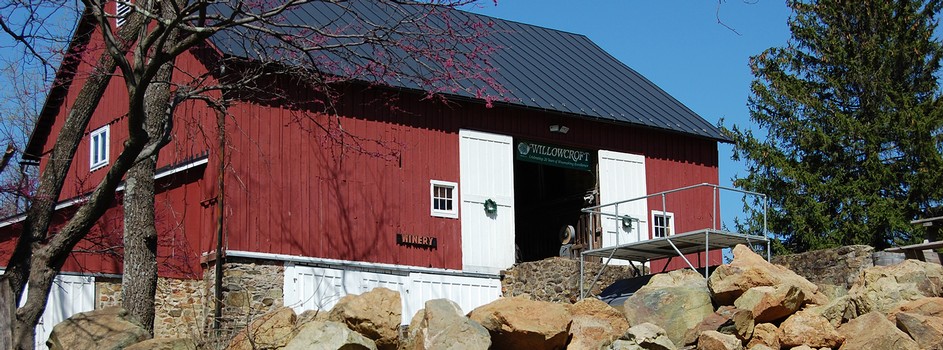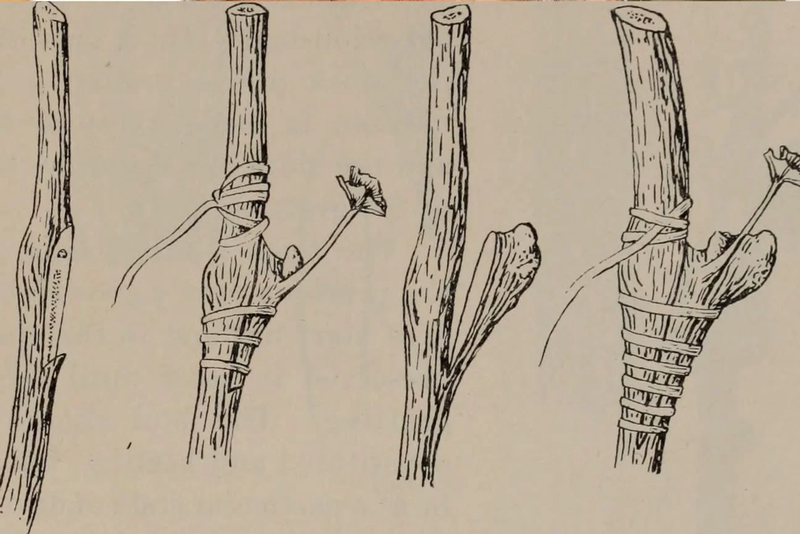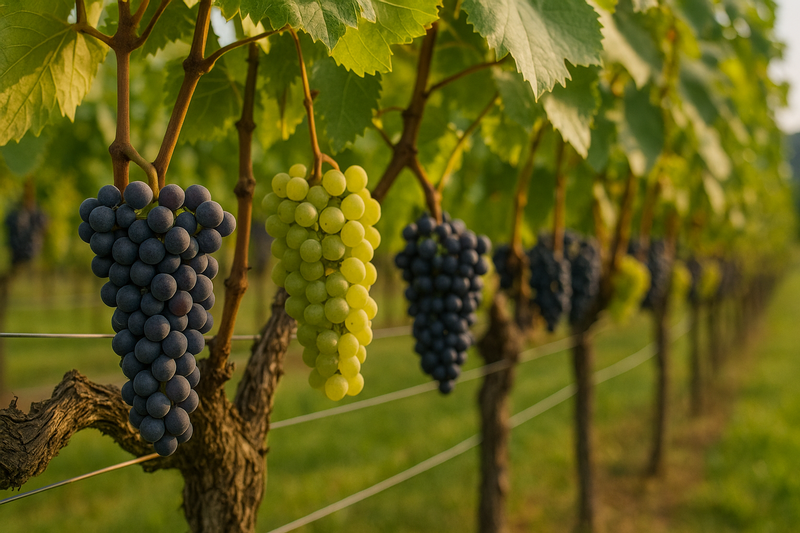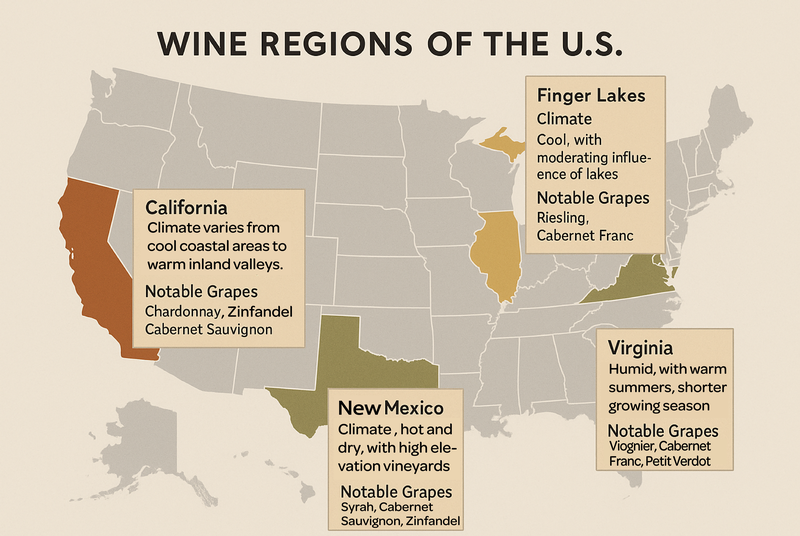News
Welcome to the Willowcroft blog! This is where we will be highlighting events and news from around the winery.
Barrel Talk: How Oak Shapes the Soul of Wine
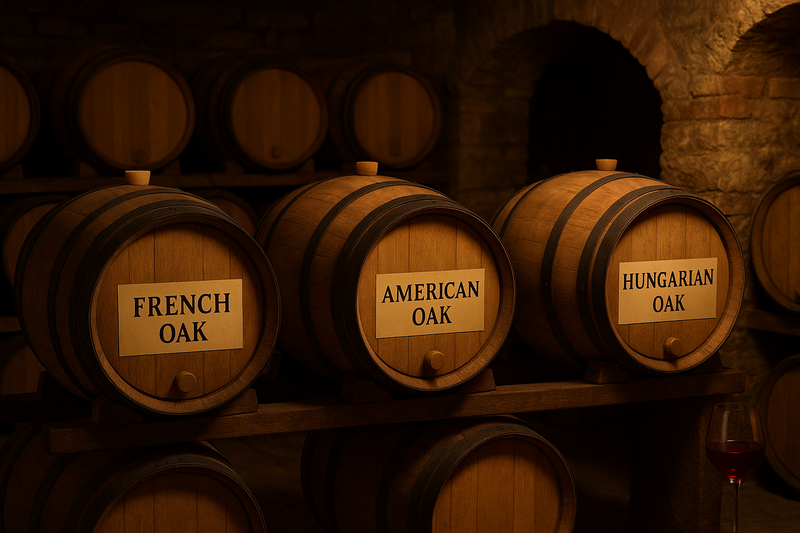
At Willowcroft, every barrel in our cellar has a story to tell—about the forest it came from, the fire that toasted it, and the wines that called it home. Oak barrels aren’t just vessels; they’re power tools that shape a wine’s texture, aroma, and flavor in ways that are both subtle and profound.
Let’s start with the basics: why use oak at all?
Oak allows minute amounts of oxygen to seep into the wine over time—a slow exchange that helps soften tannins, stabilize color, and encourage complexity. But that’s just the beginning. The wood itself contains compounds like lignin, lactones, and tannins that interact with wine to create distinctive flavor notes—think vanilla, spice, coconut, and clove.
Different oak species contribute different flavors and structures:
- French Oak (Quercus petraea): Known for its tight grain and slow extraction, French oak imparts elegant spice notes—cinnamon, clove, and nutmeg—along with a silky mouthfeel. It’s subtle and refined, often used for age-worthy reds and delicate whites.
- American Oak (Quercus alba): With a looser grain, American oak offers a more aggressive flavor profile—coconut, dill, and sweet baking spices like vanilla and nutmeg come forward more quickly. It’s a favorite for bold reds and rich whites that can stand up to its signature punch.
- Hungarian Oak (Quercus robur): Grown in the Zemplén Mountains, Hungarian oak splits the difference between French and American. It brings soft spice and creamy texture, with less sweetness than American oak and more expressiveness than French. A rising favorite for structured whites and balanced reds.
Coopers (barrel-makers) apply fire to the inside of the barrel—a process called toasting. This heat treatment breaks down oak compounds, creating new flavors.
- Light Toast: Preserves more of the wood’s raw tannins and structure. Ideal for whites, as it adds subtle spice without overwhelming freshness.
- Medium Toast: The most versatile—offering a balance of vanilla, caramel, and soft clove. It is often used for reds like Merlot or Cabernet Franc.
- Heavy Toast: Think smoke, roasted coffee, dark chocolate—great for big reds like Petit Verdot or Chambourcin that can handle the depth.
Not all barrels make the same impression—especially as they age.
- New Oak: Delivers the most substantial impact, with the most flavor extraction. Wines aged in new barrels will show clear notes of toast, spice, and structure.
- Used Oak: A second or third vintage in the barrel gives a more restrained oak influence. Used barrels still allow for micro-oxygenation, but the flavor contribution is gentler.
- Neutral Oak: After several uses, barrels no longer impart much flavor but continue to support the wine’s development through slow oxygen contact. They're a subtle tool, often used to preserve the natural fruit and terroir expression.
Oak barrels aren’t just storage—they’re storytellers. Each barrel influences a wine’s aroma, flavor, and mouthfeel, often in ways that define the wine’s identity. A typical 60-gallon barrel costs $900–$1,500, depending on the oak’s origin and toast level.
At Willowcroft, we thoughtfully blend new, used, and neutral barrels to craft balanced wines that highlight both the vineyard and the wood. Curious to taste the difference? Join us in the tasting room and ask which of our wines saw oak—you might be surprised how much that barrel adds to your glass.
Want more vineyard secrets? Explore our blog series and discover how elements like dry farming, yeast, and rootstock quietly shape every bottle.
Fermentation by Design: How Yeast Creates Style, Texture, and Taste
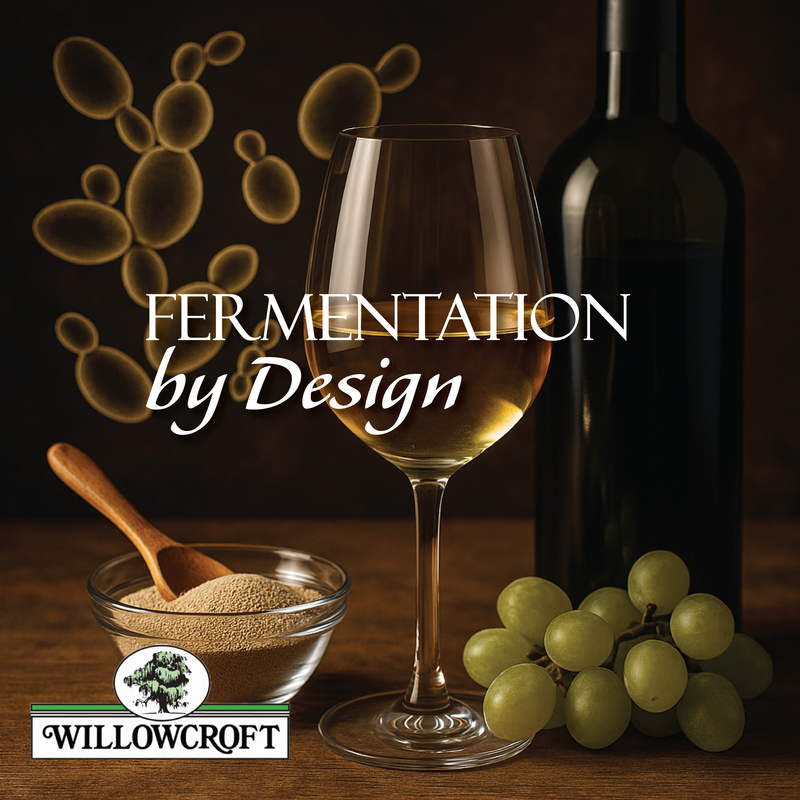
In our previous blog (Native Yeast vs. Cultured Yeast, posted August 5), we explored how winemakers choose between wild and commercial yeast to begin fermentation. But once that decision is made, the real work begins. Yeast doesn’t just start fermentation—it has an ongoing and powerful influence on how a wine tastes, feels, and evolves.
In Part 2 of our yeast series, we examine what happens after yeast is introduced and how its role influences the final product. From citrusy aromatics to creamy textures and decisions about sweetness, yeast is one of the most essential style tools in a winemaker’s hands.
The primary role of yeast is to convert the sugars in grape juice into alcohol and carbon dioxide. But along the way, yeast produces hundreds of aromatic and textural compounds. These include esters, alcohols, and amino acids that contribute to the wine’s overall flavor and mouthfeel.
The aromas we associate with different styles of wine—like citrus in a white or stone fruit in a rosé—can often be linked to the specific yeast strain used and the fermentation conditions selected. Many of these flavor notes are not found in the grapes themselves but are byproducts of fermentation.
Cultured yeasts are developed to offer specific benefits, such as promoting clean fermentation, enhancing certain aromas, or improving texture. Winemakers can select strains that support their vision for the wine, whether that’s preserving crisp acidity, deepening the mouthfeel, or ensuring a slow, even fermentation.
At Willowcroft, we thoughtfully select yeast strains based on the varietal, the vintage, and the desired outcome. Using cultured yeast enables us to consistently support clean, healthy fermentations and accurately express the style of each wine. For example, we may select strains that enhance floral or citrus notes in white wines or those that develop more structure and a smooth texture in reds. Our choices are strategic and driven by experience, with an emphasis on preserving balance, character, and purity in the final product.
Temperature is a key factor in how yeast behaves. Cooler fermentations tend to slow yeast activity and preserve more delicate aromatics, especially in white and rosé wines. This is how you get those fresh citrus or melon notes. Warmer fermentations, more typical for reds, encourage greater extraction of tannin and color and can emphasize deeper, more robust flavors.
By controlling fermentation temperature in conjunction with yeast selection, winemakers can shape the overall tone of the wine—from bright and fruit-forward to rich and layered.
Sometimes, fermentation is intentionally stopped before the yeast has converted all of the sugar into alcohol. This results in a wine with residual sugar and a naturally off-dry or semi-sweet profile. In cool-climate wines with high acidity, that small amount of sugar can create balance and lift. In others, it helps highlight specific fruit characteristics.
Stopping fermentation requires precision. The wine may be chilled to slow yeast activity, filtered to remove yeast cells, or treated with sulfur to inhibit further fermentation. These decisions must be made carefully and are often best executed when using cultured yeast, which offers predictability and cleaner outcomes.
At Willowcroft, this approach is used selectively to craft wines that remain vibrant and well-balanced, especially in varietals like Vidal Blanc or Traminette, where a touch of natural sweetness can elevate aromatics and round out the palate.
After fermentation, yeast cells settle in the wine and form what’s called the lees. In some wines, particularly white wines and sparkling wines, aging the wine on its lees can enhance richness and complexity. As the yeast cells break down, they release compounds that contribute a creamy or silky texture and subtle notes, such as those of fresh bread or nuttiness. This process—called autolysis—is a hallmark of traditional-method sparkling wine, but also plays a role in shaping the mouthfeel of certain still wines.
Lees contact is another example of how yeast contributes to the wine long after fermentation is complete, adding both weight and finesse to the wine.
Yeast is often referred to as the "invisible ingredient" in wine, but its impact is anything but subtle. Through careful strain selection, temperature control, and fermentation management, winemakers guide the development of aroma, structure, and balance.
At Willowcroft, our approach to yeast is thoughtful and deliberate. Every choice is made to support the fruit, the vintage, and the expression of the vineyard itself. Whether we’re working with a bright Albariño or a structured Petit Verdot, our yeast decisions help carry each wine from grape to glass with clarity and integrity.
Fermentation is far more than a chemical reaction—it’s a design process. Yeast doesn’t just make wine; it shapes it. From flavor to finish, yeast is one of the most potent tools in winemaking, allowing the character of the vineyard to take form in the bottle.
When you enjoy a glass of Willowcroft wine, you’re tasting more than fruit. You’re tasting the result of carefully considered choices made during fermentation—choices that preserve freshness, amplify expression, and deliver a wine with style and purpose.
Rootstock Rebellion: How the Bottom Half of the Vine Shapes the Wine
The Unsung Hero Beneath Every Great Vintage
Ask a wine lover to name what shapes a wine’s character, and you’ll hear about grape varieties, climate, barrels—even yeast. But there’s one key player almost no one talks about: rootstocks.
These humble underground structures don’t make headlines or tasting notes, but they’re the very foundation of modern viticulture. They protect against pests, adapt vines to challenging soils, and influence everything from how grapes ripen to how the wine tastes. At Willowcroft, where we farm without irrigation and face Virginia’s humid summers, choosing the right rootstock isn’t optional—it’s vital.
So why don’t we hear more about them? To answer that, let’s dig into history, science, and a little Texas-sized adventure.
In simplest terms, a rootstock is the underground part of the vine—the roots—that’s grafted to the fruiting vine (the part above ground that produces the grapes). The fruiting vine is typically Vitis vinifera, the classic European grapevine species behind beloved varietals like Chardonnay, Cabernet Sauvignon, and Merlot.
The rootstock, however, often comes from other grape species. Why? Because it acts like the engine of growth, protecting vines from pests, diseases, and environmental stress. It also influences vigor, water uptake, nutrient absorption, and even how a grapevine copes with Virginia’s frequent heat and humidity.
Rootstocks became essential during the 19th century when Europe’s vineyards were nearly wiped out by phylloxera, a tiny root-feeding insect native to North America. European vinifera vines had no resistance to the pest. The solution? Grafting them onto American rootstocks, which had evolved alongside phylloxera and developed natural defenses.
The first rootstocks tried—Vitis riparia—thrived in moist, fertile riverbank soils but failed in the dry, calcareous soils of regions like Champagne and Burgundy. Then came Vitis rupestris, better suited to stony soils but still unhappy in limestone-rich areas.
The breakthrough came when botanists like Pierre Viala and Thomas Volney Munson identified Vitis Berlandieri, a Texas native thriving in dry, chalky soils. Though difficult to propagate, Berlandieri became the backbone for hybrid rootstocks like 41B, which saved French vineyards and remains in use today.
Virginia’s climate brings its own set of hurdles for grapevines. Our summers often deliver long stretches of heat and humidity without relief, creating the perfect conditions for fungal diseases like powdery mildew and botrytis. Pair that with dry-farmed hillsides and variable soils, and rootstock selection becomes not just important, but essential.
The right rootstock helps balance vigor, resist disease, and manage water uptake in these demanding conditions. Some, like Petit Verdot’s small, tight clusters, naturally help resist moisture intrusion, but beneath the surface, it’s the rootstock doing much of the heavy lifting.
💡 To better understand how different rootstocks perform, here’s a quick chart showing key rootstock types, their strengths, and where they shine in the vineyard:
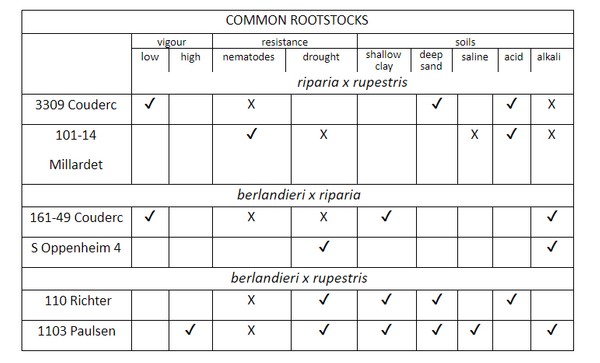
This snapshot helps demystify the role of rootstocks and shows why their selection matters as much as the grape variety grafted above them.
Today, nearly all commercial vineyards rely on rootstocks derived from the same small group of species: vinifera, riparia, rupestris, and Berlandieri. But nature doesn’t stand still. Phylloxera has evolved into numerous biotypes and superclones, while climate change introduces new challenges like extreme drought and shifting soil salinity.
Some researchers are exploring wild Asian grape species for new traits. Others argue for modern methods, including genetic modification (GM), to develop next-generation rootstocks. This remains controversial, but so was grafting American roots to French vines—until it saved the world’s wine industry.
Rootstocks are more than a technicality—they shape:
🌿 Vine vigor and health
💧 Drought tolerance and disease resistance
🍇 Ripening speed and fruit quality
🌱 Sustainability in challenging climates
At Willowcroft, we see them as quiet partners in the vineyard, helping us produce elegant, expressive wines—year after year—even in Virginia’s demanding environment.
So next time you swirl a glass of Petit Verdot or Chardonnay, raise a silent toast to the roots beneath your feet.
Visit Willowcroft for a tasting or tour, and ask us about the vines in your glass. There’s a world of science and history lying just below the soil.
🍇 Grape Clones & Hybrids: What They Are and Why They Matter
A Willowcroft Deep Dive into the Genetics of Great Wine
Not all Chardonnay is created equal.
Not even all Merlot.
In fact, even within the same vineyard block, the grapes growing just a few feet apart might come from entirely different genetic lineages.
Most wine lovers are surprised to learn how much grape genetics influence what’s in their glass. At Willowcroft, we take pride in our deep connection to both classic vinifera grapes—like Cabernet Sauvignon, Cabernet Franc, and Chardonnay, which were among our original plantings—and to modern hybrid varieties that have helped us thrive in Virginia’s unique growing environment.
Understanding how clones and hybrids work is key to appreciating the science and artistry behind every bottle we produce. And no, none of this involves GMOs—so let’s set the record straight.
Clones are genetically identical copies of a single "mother vine" that showed exceptional traits, like superior flavor, disease resistance, or early ripening. Cuttings, not seeds, propagate these vines, allowing them to retain the exact DNA of their origin.
Think of clones as siblings from the same exceptional parent, each expressing slightly different characteristics based on where they’re planted. For example, Chardonnay Clone 96 may bring out bright citrus and body, while Clone 76 delivers more floral and elegant tones.
Across the industry, clonal selection is key to maximizing quality. It helps us:
- Adapt to different vineyard blocks
- Improve disease resistance naturally
- Fine-tune flavor and ripening windows for our dry-farmed, hillside sites
From the beginning, Willowcroft has championed vinifera—the noble European species behind the world’s most iconic wines. Our early plantings of Cabernet Sauvignon, Cabernet Franc, and Chardonnay were rooted in this tradition and remain foundational to our portfolio today.
But Virginia is not Bordeaux or Burgundy. Our summers bring persistent heat and humidity, often without a reprieve from the heat. These humid streaks—lasting days, weeks, or even months—can place significant stress on the vines, increasing the risk of fungal diseases, rot, and uneven ripening. That’s where clonal selection and strategic hybrid use become critical. By selecting varietals and clones adapted to our specific conditions—such as Petit Verdot, whose small, tight clusters naturally help resist moisture intrusion—we can produce wines of integrity, character, and resilience, even in challenging years.
Hybrid grapes are crosses between different grape species, typically blending vinifera with native American grapes like Vitis labrusca or Vitis riparia. These intentional crosses are bred for strength: they’re often more resistant to disease, cold, humidity, and pests.
At Willowcroft, we proudly grow several hybrids that have earned fan-favorite status:
- Seyval Blanc – Crisp and citrusy, great for warm days and cool nights
- Chambourcin – Deep, fruit-forward, and perfect with pork or lamb
- Traminette – Spicy and floral, with Gewürztraminer in its lineage
Here’s the truth:
Hybrids are not genetically modified organisms (GMOs).
Hybrids are created through traditional plant breeding—crossing two grape varieties and selecting the best offspring. It’s a slow, deliberate process, often taking years or even decades.
GMOs, on the other hand, involve lab-based DNA manipulation, often introducing genes from unrelated species. Currently, no GMO grapes are used in commercial winemaking in the United States.
So while some folks hear “hybrid” and think “science experiment,” the reality is that hybrids are a time-honored, nature-guided solution to challenges like climate, pests, and sustainability.
Your wine starts long before the bottle—with decisions about what to plant, where, and why. Whether we’re choosing a Cab Franc clone for improved ripening or a hybrid like Seyval to reduce disease pressure, every choice in the vineyard shapes what you taste in the glass.
These selections affect:
- 🍇 Flavor profiles and aromatic intensity
- 🌿 Farming sustainability (especially in dry-farmed systems like ours)
- 🌦️ Adaptation to climate and disease pressure
- 📦 Consistency across vintages and vineyard blocks
Join us in the tasting room or attend one of our vineyard tours to see how these choices play out in real time, from bud break to bottle. The more you know, the better it tastes—and we’re always happy to pour and chat.
How Is Champagne Made? A Guide to Sparkling Wine Production Methods
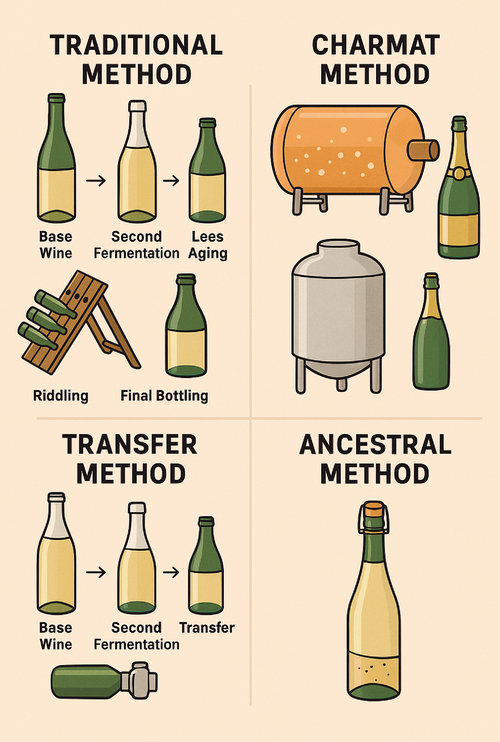
Sparkling wine is known for its festive bubbles, but not all fizz is created the same way. Champagne—arguably the world’s most iconic sparkling wine—is crafted using a time-intensive technique called the Traditional Method, or Méthode Champenoise. This process gives Champagne its signature fine bubbles, rich mouthfeel, and toasty, yeasty complexity.
But it’s not the only method. Let’s explore how sparkling wines are made, starting with the classic and moving through alternative worldwide techniques.
This is the most meticulous and respected method of making sparkling wine, used for Champagne, Crémant, Cava, and other premium wines.
- Step 1: Base Wine Production
Winemakers begin by creating a still (non-sparkling) wine from grapes, usually dry and high in acidity. These base wines are often blended from different vineyards, grape varieties, or vintages. - Step 2: Second Fermentation in Bottle
A mixture of sugar and yeast, called the liqueur de tirage, is added to the base wine, which is then sealed in individual bottles. This triggers a second fermentation, which produces carbon dioxide—the source of the bubbles. - Step 3: Lees Aging (Yeast Autolysis)
As the yeast cells finish fermenting the sugar, they die and settle inside the bottle, creating a layer of sediment known as lees. Wines are often aged on these lees for months or even years to develop richer textures and flavors like brioche, toast, and hazelnut. - Step 4: Riddling (Remuage)
Bottles are slowly tilted and rotated, traditionally by hand, to move the sediment down into the neck of the bottle. - Step 5: Disgorgement
The neck of the bottle is frozen, and the plug of frozen lees is ejected. The wine is topped up with a mixture of wine and sometimes sugar (called the dosage) to balance flavor before final sealing. - Step 6: Final Bottling and Labeling
The finished wine is corked, wired, labeled, and ready for enjoyment!
Not all sparkling wines are made using the traditional method. Here are a few other approaches:
- Charmat Method (Tank Method)
This method, used for Prosecco and many fresh, fruit-driven sparkling wines, carries out the second fermentation in a large, pressurized stainless steel tank rather than in individual bottles. It’s faster and less expensive, but it creates larger, less persistent bubbles and minimal yeast character. - Transfer Method
A hybrid of the traditional method, this approach starts with bottle fermentation, but the wine is then transferred to a tank, filtered, and rebottled. It’s more efficient and avoids riddling while retaining some lees influence. - Ancestral Method (Pét-Nat)
Short for Pétillant Naturel, this ancient method allows the wine to finish its fermentation in the bottle without added yeast or sugar. The result is a lightly sparkling, often cloudy wine that can be funky, unpredictable, charming, and fresh. - Continuous Method
This method, used less commonly today, involves continuous fermentation across several connected tanks, creating a steady stream of sparkling wine.
The method used to produce a sparkling wine significantly impacts the final experience in your glass. While the Traditional Method creates wines with finer bubbles and more complex flavors, other methods can produce fun, fresh wines perfect for casual sipping.
Whether you're popping Champagne for a celebration or toasting with a bright glass of Prosecco on the patio, knowing how your bubbles are made can deepen your appreciation—and guide you to styles you’ll love.
How Climate Shapes the Wines We Love: A Look at Four Unique Regions
If you’ve ever wondered why a Chardonnay from California tastes so different from one grown in Virginia or New York’s Finger Lakes, the answer often lies in one word: CLIMATE.
From the first bud break in spring to the final harvest in fall, a wine region's climate profoundly shapes the grapes it grows and the wine it ultimately produces. Understanding how climate influences wine is a fascinating way to deepen your appreciation for each glass.
- Warm climates promote faster ripening, leading to grapes with higher sugar content and lower acidity and typically more intense, full-bodied wines with higher alcohol and lush, ripe fruit flavors.
- Cool climates slow the ripening process, resulting in grapes with higher acidity and lower sugar and wines that are lighter, brighter, and often more nuanced.
But there’s more to climate than just temperature. Let’s explore some other key factors—and how they play out in a few distinct U.S. wine regions, including our home here in Virginia.
Sunlight is essential to photosynthesis and sugar development in grapes, but balance is key.
- Too little sun? Grapes may not fully ripen.
- Too much? Sunburned fruit and imbalanced wines.
Virginia's warm summer days and cool mountain nights give us the perfect mix, particularly atop the Catoctin Ridge where our vineyards are perched. That diurnal shift preserves acidity and builds complexity in grapes like Cabernet Franc and Albarino.
California, particularly in Napa or Paso Robles, experiences more intense, consistent heat and sun. This translates to wines with bolder body, ripe fruit flavors, and typically higher alcohol levels—think classic California Cabernet Sauvignon or Zinfandel.
Rain and humidity can make or break a vintage.
- Too much rainfall close to harvest? Grapes swell and lose concentration.
- High humidity increases disease risk, especially for tightly clustered grapes like Riesling or Chardonnay.
The Finger Lakes region in New York experiences a short growing season and cooler, often wetter conditions. But the lakes themselves help moderate the climate, making the area ideal for high-acid, aromatic whites like Riesling and Gewürztraminer.
New Mexico, where we’ve recently partnered for special tastings, is a high-elevation, semi-arid wine region. With ample sunshine and low humidity, grapes ripen well while maintaining freshness, particularly important for varietals like Syrah, Tempranillo, and sparkling wine grapes.
As global temperatures rise, winemakers around the world are being challenged to adapt:
- Earlier ripening can mean unbalanced sugar and acid levels.
- Shifts in suitability lead to new wine regions emerging, while traditional ones are being pushed to evolve.
At Willowcroft Farm Vineyards, we stay informed and nimble, choosing disease-resistant rootstocks, using canopy management to optimize sun exposure, and continually evaluating what grows best in our changing climate. Our recent addition of Albarino is one such adaptation—and it’s been a thrilling success.
From the rolling hills of Virginia to the dry elevations of New Mexico, the sun-soaked vineyards of California, and the cool, lake-influenced slopes of New York, climate gives every region its signature. For wine lovers, understanding these differences isn’t just educational—it’s delicious.
So next time you swirl a glass, consider the climate story behind it. It might just change the way you taste.
Wine Grapes vs. Table Grapes: What’s the Difference?

When you walk through the produce aisle, you’ll find plump, juicy grapes ready for snacking. But step into a vineyard, and the grapes look quite different—smaller, darker, and often less sweet. So, what sets wine grapes apart from table grapes (sometimes used for jelly and juice)? It all comes down to size, skin thickness, sugar levels, seeds, and purpose.
1. Size & Appearance
- Smaller and more compact in clusters.
- Thick skins and a higher ratio of skin to juice, contributing to deep color and tannins.
- Often darker and more intense in hue for reds; golden or green for whites.
- Larger, plumper, and juicier.
- Thinner skins for easy eating.
- Uniform in color, often bright green or deep red, bred for visual appeal.
2. Sugar & Acidity Levels
Wine grapes have higher sugar content (24-28% sugar, or 24-28° Brix) to allow for fermentation into alcohol.
- Table grapes contain less sugar (typically around 15-17° Brix) and more water, making them refreshing but unsuitable for winemaking.
- Wine grapes maintain higher acidity, which is crucial for balance in winemaking, while table grapes are milder in acidity, making them sweeter to eat.
3. Seeds vs. Seedless
- 🍷 Wine Grapes: Typically contain seeds, which contribute to tannins in the winemaking process. Some varieties (like Sémillon) can be nearly seedless but are rare.
- 🍇 Table Grapes: Usually seedless for convenience, thanks to selective breeding.
4. Purpose: Eating vs. Winemaking
- Table grapes are bred for fresh consumption, meaning they focus on crisp texture, juiciness, and mild sweetness.
- Wine grapes are grown to be fermented into wine, meaning they need higher sugar, acidity, tannins, and complex flavors to create a balanced final product.
5. Growing Conditions & Farming Practices
- Dry-farmed or minimally irrigated, allowing deep roots to pull minerals from the soil.
- Lower-yielding vines (grapes per vine) to concentrate flavors.
- Harvested once per season at peak ripeness, often by hand for premium wines.
- Heavily irrigated for plumpness.
- Grown for high yields, meaning more grapes per vine but with less concentrated flavors.
- Often harvested multiple times for consistent supply.
Technically, yes—but it won’t taste great. Because table grapes have lower sugar and acidity and higher water content, any wine made from them would be diluted, overly sweet, and lacking in depth. Table grape skins also contain fewer tannins, which means red wine made from them won’t have the structure or aging potential of true wine grapes.
While both table grapes and wine grapes come from the Vitis family, their differences make them suited for entirely different purposes. Table grapes are bred for fresh eating—crisp, juicy, and mild—while wine grapes are cultivated for complexity, sugar, acidity, and depth, all necessary for crafting fine wine.
Next time you enjoy a glass of Willowcroft wine, remember that these grapes weren’t meant for snacking—they were grown with intention, patience, and tradition to bring out the best flavors in every sip. 🍷
The Terroir Connection: How Soil Shapes the Flavor and Quality of Wine
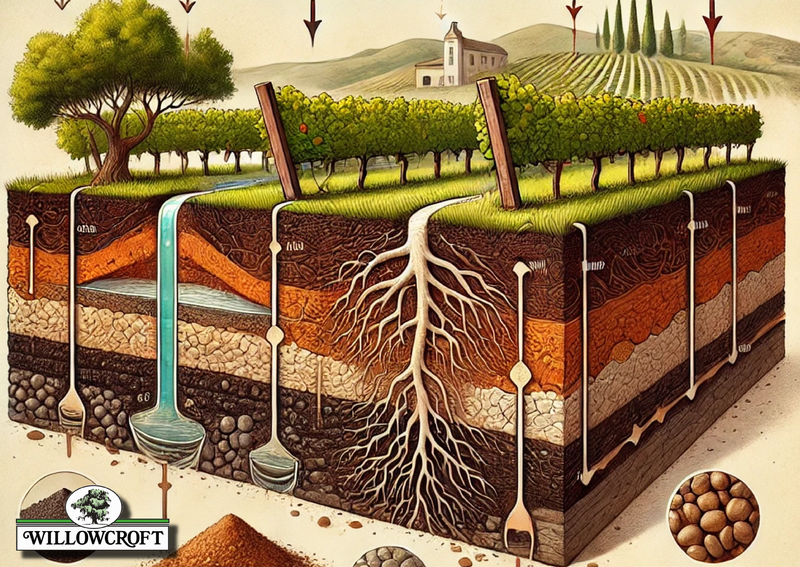 The soil in which grapevines grow plays a crucial role in winemaking, influencing everything from water management to the flavors in the final product. Understanding soil characteristics can help vintners decide to cultivate healthy vines and produce quality wines.
The soil in which grapevines grow plays a crucial role in winemaking, influencing everything from water management to the flavors in the final product. Understanding soil characteristics can help vintners decide to cultivate healthy vines and produce quality wines.
Particle Size, Drainage, and Water Retention
Soil texture—defined by the proportion of sand, silt, and clay—affects water drainage and retention, which are vital for vine health. Sandy soils have larger particles and larger pore spaces, allowing for quick drainage but limited water retention. Conversely, clay soils consist of smaller particles and smaller pore spaces, leading to slower drainage and higher water retention. Loam soils, which are a balanced mix of sand, silt, and clay, offer moderate drainage and water-holding capacity, often considered ideal for viticulture. The right balance ensures that vine roots receive adequate moisture without becoming waterlogged, promoting deep root growth and resilience.
Soil Color, Sun Reflection, and Heat Absorption
The color of soil can influence its temperature by affecting how it absorbs and reflects sunlight. Darker soils tend to absorb more heat, which can be beneficial in cooler climates by promoting earlier ripening of grapes. Lighter-colored soils, such as those rich in limestone or chalk, reflect more sunlight, potentially keeping the soil cooler and delaying ripening. This reflection can also enhance light exposure to the grape clusters, aiding in photosynthesis. Managing soil temperature through color and composition helps vintners control the ripening process and grape development.
Soil Composition and Flavor Influence
Beyond texture and color, the mineral composition of soil can subtly influence the flavor profile of wines. For instance, calcareous soils, which are rich in calcium carbonate, are known to retain water effectively and can impart a certain acidity to the grapes, contributing to a wine's freshness. Clay soils, with their excellent water retention, can produce bold and structured wines, making them suitable for varieties like Merlot and Sangiovese. While the direct impact of soil minerals on wine flavor is complex and not fully understood, the interplay between soil composition, water availability, and vine health undeniably shapes the characteristics of the wine.
In summary, a deep understanding of soil properties—including particle size, color, and composition—enables winemakers to optimize vine health and influence the sensory qualities of their wines.
From Snow to Bud Break: The Promise of a New Season in Northern Virginia Vineyards
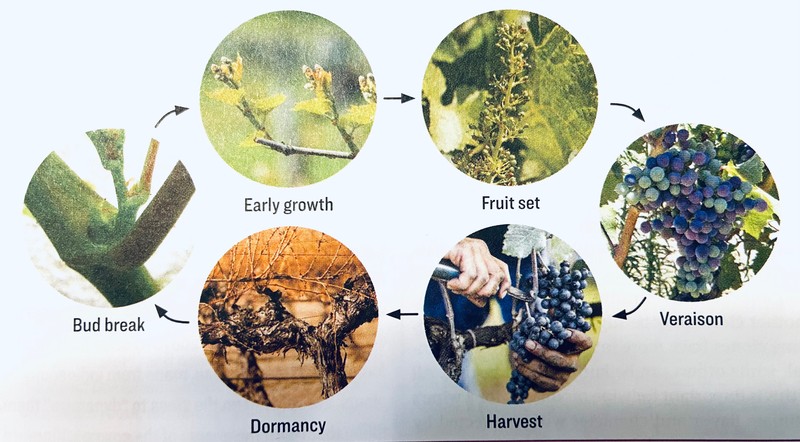
Northern Virginia has been blanketed by more snow and colder temperatures than usual as we find ourselves in the heart of winter. Notably, early January brought significant snowfall, with areas like Leesburg receiving more than 7 inches. While the landscape rests under this frosty veil, it's heartening to remember that the vineyards will begin their annual renewal in just about six weeks.
Grapevines are dormant, appearing as mere woody twigs amidst the snow. This essential period allows vines to conserve energy and prepare for the upcoming growth cycle. As temperatures start to rise and the ground begins to thaw, the first signs of life emerge with bud break. Tiny buds swell and burst open, revealing new shoots and leaves, marking the vine's reawakening.
Following bud break, the vines enter a phase of rapid growth. Shoots lengthen, and small, self-pollinating flowers appear. These blossoms, once pollinated, develop into tiny green berries. As summer progresses, these berries undergo veraison, changing color and beginning to ripen. The grapes reach their peak ripeness by late summer to early fall, ready for harvest.
The current winter conditions, though harsh, play a crucial role in this cycle. The cold ensures that vines remain dormant, protecting them and allowing for a more synchronized and healthy bud break come spring. So, as we navigate these chilly days, take comfort in knowing that the vineyards are merely resting, gathering strength for a vibrant season ahead. In just a few weeks, we'll witness the first signs of this transformation, a testament to nature's resilience and the promise of warmer days.
The Critical Role of Weather in Summertime Grape Growing
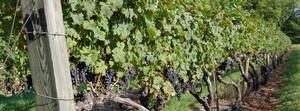 As the sun shines brightly over our picturesque vineyard, the importance of weather during the summer months becomes profoundly clear. At Willowcroft Farm Vineyards, the weather intricately influences every grape’s journey from vine to glass, making it a critical factor in the art of winemaking. This summer, we face another challenge: a significant drought affecting Northern Virginia, including Loudoun County.
As the sun shines brightly over our picturesque vineyard, the importance of weather during the summer months becomes profoundly clear. At Willowcroft Farm Vineyards, the weather intricately influences every grape’s journey from vine to glass, making it a critical factor in the art of winemaking. This summer, we face another challenge: a significant drought affecting Northern Virginia, including Loudoun County.
Summer weather plays a pivotal role in grape development, influencing the balance of acidity, sweetness, and the overall flavor profile of the wine. Warm, sunny days are essential for photosynthesis, helping the grapes accumulate sugars and develop rich flavors. However, it’s not just about the heat; cooler nights are equally important. They help preserve the acidity in the grapes, ensuring the wine maintains its refreshing qualities and complexity.
This year’s drought adds a layer of complexity to our grape-growing process. While some stress on the vines can lead to more concentrated flavors in the grapes, a prolonged lack of water can pose significant risks. Water-stressed vines may produce fewer grapes, and extreme conditions can affect the overall health of the vines, making them more susceptible to diseases and pests. At Willowcroft, we are carefully managing our water resources and employing strategies such as mulching and strategic irrigation to mitigate the impact of the drought.
Despite these challenges, our commitment to producing high-quality wine remains unwavering. Our experienced team closely monitors the vines and adapts our vineyard management practices to ensure our grapes reach their full potential. The delicate balance of nature and our dedicated efforts will ensure that Willowcroft wines continue to delight your palate even in the face of drought.
For more insights into our winemaking process or to join us for a tasting, visit our calendar of events page or email Kim at kim@willowcroftwine.com.

